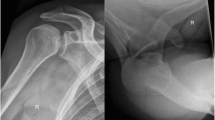Abstract
Introduction
Focal Outerbridge grade IV cartilage defects of the proximal humerus may lead to pain and an impaired shoulder function. In cases of failed operative or conservative treatment options such as intraarticular injections or arthroscopic microfracturing of the subchondral bone, partial arthroplasty of the humeral may restore the articular surface of the humeral head without altering the anatomy. This study evaluates mid-term results of open and arthroscopic partial resurfacing of the humeral head in the context of focal grade IV cartilage defects.
Methods
Eighteen patients (f = 3, m = 15, mean age = 57.7 years) out of 22 patients were available for follow-up after 65 (24–116) months. Thirteen patients were treated with a partial humeral head prosthesis in an open technique and five patients received a partial humeral head prosthesis in an arthroscopic technique.
The patients were followed-up clinically using the Constant-Score, the ASES Score as well as the range of motion. Plain radiographs (anterior–posterior and axial view) were carried out for radiologic assessment.
Results
At follow-up the mean CS rated 79.5. The mean ASES Score was 85.8 points. Mean active forward flexion measured 163.8°, while mean active abduction was 160.0°. The average pain level on a visual analogue scale (VAS) made out 0.7 out of 10. Patients treated with an arthroscopically implanted prosthesis achieved a mean CS of 88.8 points and a mean ASES Score of 92.6 points. The patients with openly implanted prosthesis had a CS of 75.3 points and an ASES Score of 83 points.
There were no intraoperative or immediate postoperative complications. Until the final follow-up one patient needed to be converted to total shoulder arthroplasty due to progressive glenohumeral osteoarthritis. Nine patients (50%) showed progressive glenohumeral osteoarthritis. Aseptic loosening of the implants was not observed.
Conclusion
Partial arthroscopic or open arthroplasty of the humeral head is related to good functional results after mid-term follow-up. Resurfacing of the humeral head is a safe procedure without any implant-related complications. There is a risk for progression of glenohumeral osteoarthritis, which may require surgical revision with conversion to anatomic shoulder arthroplasty.
Level of evidence
Level IV (retrospective study).




Similar content being viewed by others
References
Lafforgue P (2006) Pathophysiology and natural history of avascular necrosis of bone. Joint Bone Spine 73:500–507
Cole BJ, Yanke A, Provencher MT (2007) Nonarthroplasty alternatives for the treatment of glenohumeral arthritis. J Shoulder Elbow Surg 16:S231–240
Frank RM, Van Thiel GS, Slabaugh MA et al (2010) Clinical outcomes after microfracture of the glenohumeral joint. Am J Sports Med 38:772–781
Kim SH, Wise BL, Zhang Y et al (2011) Increasing incidence of shoulder arthroplasty in the United States. J Bone Joint Surg Am 93:2249–2254
Millett PJ, Huffard BH, Horan MP et al (2009) Outcomes of full-thickness articular cartilage injuries of the shoulder treated with microfracture. Arthroscopy 25:856–863
Romeo AA, Cole BJ, Mazzocca AD et al (2002) Autologous chondrocyte repair of an articular defect in the humeral head. Arthroscopy 18:925–929
Scheibel M, Bartl C, Magosch P et al (2004) Osteochondral autologous transplantation for the treatment of full-thickness articular cartilage defects of the shoulder. J Bone Joint Surg Br 86:991–997
Buchmann S, Salzmann GM, Glanzmann MC et al (2012) Early clinical and structural results after autologous chondrocyte transplantation at the glenohumeral joint. J Shoulder Elbow Surg 21:1213–1221
Sweet SJ, Takara T, Ho L et al (2015) Primary partial humeral head resurfacing: outcomes with the HemiCAP implant. Am J Sports Med 43:579–587
Delaney RA, Freehill MT, Higgins LD et al (2014) Durability of partial humeral head resurfacing. J Shoulder Elbow Surg 23:e14–22
Sowa B, Petersen M, Maier M et al (2020) Does the degree of osteoarthritis influence the clinical outcome after anatomic total shoulder arthroplasty? Arch Orthop Trauma Surg. https://doi.org/10.1007/s00402-019-03328-y
Schnetzke M, Wittmann T, Raiss P et al (2019) Short-term results of a second generation anatomic short-stem shoulder prosthesis in primary osteoarthritis. Arch Orthop Trauma Surg 139:149–154
Burgess DL, Mcgrath MS, Bonutti PM et al (2009) Shoulder resurfacing. J Bone Joint Surg Am 91:1228–1238
Bessette MC, Frisch NC, Kodali P et al (2017) Partial resurfacing for humeral head defects associated with recurrent shoulder instability. Orthopedics 40:e996–e1003
Ranalletta M, Bertona A, Tanoira I et al (2019) Results of partial resurfacing of humeral head in patients with avascular necrosis. Rev Esp Cir Ortop Traumatol 63:29–34
Uribe JW, Botto-Van Bemden A (2009) Partial humeral head resurfacing for osteonecrosis. J Shoulder Elbow Surg 18:711–716
Anderl W, Kriegleder B, Neumaier M et al (2015) Arthroscopic partial shoulder resurfacing. Knee Surg Sports Traumatol Arthrosc 23:1563–1570
Ameziane Y, Schneider KN, Gosheger G et al (2020) Single-row vs. double-row refixation of the subscapularis tendon after primary anatomic shoulder arthroplasty. Arch Orthop Trauma Surg. https://doi.org/10.1007/s00402-020-03423-5
Author information
Authors and Affiliations
Corresponding author
Ethics declarations
Conflict of interest
All authors of this study do not have any conflicts of interest related to the subject of this work.
Ethical approval
Ethical approval was given from the ethical committee of the medical faculty of the University of Münster, Munster, Germany on September 7th 2018 (study number: 2017-150-f-S).
Informed consent
Informed consent was obtained from all individual participants included in the study.
Additional information
Publisher's Note
Springer Nature remains neutral with regard to jurisdictional claims in published maps and institutional affiliations.
Rights and permissions
About this article
Cite this article
Holschen, M., Berg, D., Schulte, T. et al. Arthroscopic and open partial arthroplasty for the treatment of focal grade IV cartilage defects of the humeral head. Arch Orthop Trauma Surg 141, 1455–1462 (2021). https://doi.org/10.1007/s00402-020-03552-x
Received:
Accepted:
Published:
Issue Date:
DOI: https://doi.org/10.1007/s00402-020-03552-x




